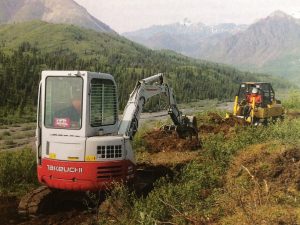By Dave Halsey, NOHVCC Contributing Writer
 “It can be easier to teach a rider how to be an equipment operator than to teach a seasoned heavy equipment operator how to build a trail.”
“It can be easier to teach a rider how to be an equipment operator than to teach a seasoned heavy equipment operator how to build a trail.”
That’s one of many insights offered by Dick Dufourd in his book, “Great Trails: Providing Quality OHV Trails And Experiences.”
Chapter 8, titled “Tools in the Toolbox: Equipment,” is 15 pages of information valuable to both rookie and veteran builders of off-highway vehicle (OHV) trails. It includes 60 photographs, illustrating the many types of hand tools, power tools and specialized, heavy equipment to consider when trail building.
“For program managers, equipment poses a multitude of questions with not-so-easy answers,” writes Dufourd. “Including what needs to be bought and when? How will it be paid for? Where will it be stored and how will it be moved around? And who will operate, maintain and repair it?”
Dufourd puts heavy equipment into five performance categories: loaders, haulers, pushers, diggers and other. “Some equipment like dozers perform as pushers, while others, like excavators and skid steers, have the ability to perform well as loaders, haulers and diggers. Trail dozers are purpose-built for trail building. Though small in size, they are powerful and versatile with a six-way blade and draw bar with rippers. A variety of attachments are available.” Chapter 8 includes 25 photographs of heavy equipment shown in a wide variety of applications.
Whether you’re building a 50-inch trail for ATVs or a single-track trail for motorcycles, proper operation of heavy equipment is critical. “More important than the size and type of equipment is the skill, motivation and finesse of the operator,” says Dufourd. “Trail planners and designers can have a great design, but it’s the operator who puts it on the ground and keeps it maintained.
“Motorcycle riders have always coveted sweet single-tracks. Purists will say that the only good single-track is hand-built because it is more natural. Mechanized trail building is 10 times faster and cheaper than building by hand. When done properly, it is pretty hard to tell a hand-built trail from a machine-built trail.”
A theme that runs through the chapter is to avoid buying or renting equipment that is larger than the  trail being built. Dufourd shows and describes a variety of trail-size equipment, with their pros and cons. They include drags, rakes, blades, rollers, and trailers that help get materials and supplies to a trail work-site. Also included is a table comparing the pros and cons of steel tracks, rubber tracks and tires.
trail being built. Dufourd shows and describes a variety of trail-size equipment, with their pros and cons. They include drags, rakes, blades, rollers, and trailers that help get materials and supplies to a trail work-site. Also included is a table comparing the pros and cons of steel tracks, rubber tracks and tires.
A section on hand tools and mechanized tools offers a great introduction to clubs new to trail building. It includes descriptions of common tools such as the Pulaski, McLeod, loppers and others.
Another insight from Dufourd: “Three common mistakes that are made when purchasing tools are: 1) not buying a good variety of tools like shovels, Pulaskis, and McLeods; 2) not buying enough of each tool; and 3) not buying or renting the right specialty tools (like drills, augers, and rock hammers) that make tough tasks easier.”
Additional information is also included covering Personal Protective Equipment (PPE), and safety measures to take when using or being around heavy equipment, and not crowding each other when working on trails with hand tools.
“Great Trails” is a resource guide published in 2015 by the National Off-Highway Vehicle Conservation Council (NOHVCC). You can purchase a copy of the 350-page, fully illustrated book for $30, or download the book in separate pdf files, free of charge. To get started, go to http://gt.nohvcc.org .